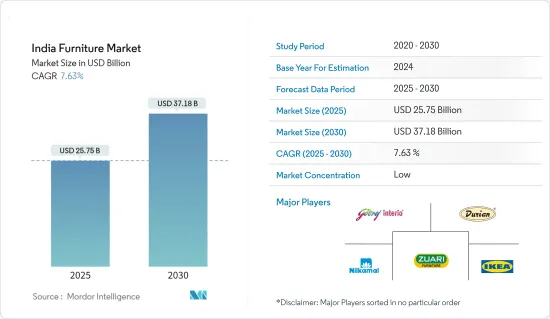
|
市場調査レポート
商品コード
1689857
インドの家具:市場シェア分析、産業動向・統計、成長予測(2025年~2030年)India Furniture - Market Share Analysis, Industry Trends & Statistics, Growth Forecasts (2025 - 2030) |
||||||
カスタマイズ可能
適宜更新あり
|
|||||||
| インドの家具:市場シェア分析、産業動向・統計、成長予測(2025年~2030年) |
|
出版日: 2025年03月18日
発行: Mordor Intelligence
ページ情報: 英文 120 Pages
納期: 2~3営業日
|
全表示
- 概要
- 目次
インドの家具市場規模は2025年に257億5,000万米ドルと推定され、予測期間(2025-2030年)のCAGRは7.63%で、2030年には371億8,000万米ドルに達すると予測されています。

インドの家具市場は進化しています。インドの家具市場の勃興は、中間層の増加、可処分所得の上昇、都市部の住居の増加によって促進されています。インドの家具セクターを支配しているのは、未組織の小規模な地元企業です。しかし、過去10年間で、組織化された企業がインド家具市場への参入を拡大してきました。インド各州の都市化、耐久性のあるハイブリッド家具への需要の高まり、モジュラー家具や最先端家具への需要の高まりはすべて、同国の家具事業拡大を後押しする要因です。また、インドの木材産業の隆盛も家具の低価格化に貢献しています。これらの要因が同国の家具市場の成長を後押しすると予想されます。
さらに、インドではモバイルショッピングやインターネットショッピングの普及が進んでいるため、オンラインチャネルを通じた家具需要の増加が見込まれます。観光・ホスピタリティ部門や企業部門もインド家具市場の拡大を後押ししています。ホテルや企業オフィスの増加が、同国の家具需要をさらに押し上げています。
インドの家具市場の動向
消費者の嗜好の変化が市場成長の原動力
西洋文化の影響が大きくなるにつれ、消費者の嗜好が変化しています。インドの大都市では、適応性の高いスタイリッシュな家具への需要が高まっています。大都市の急速な台頭と住宅セクターの開発により、人々の生活水準と生活は大きく変化しています。さらに、消費者が持続可能性やリサイクルの重要性を意識するようになるにつれ、プラスチック製の家具よりも人工木製の家具や再生家具を好むようになり、十分な情報を得た上で購入を選択するようになっています。その結果、拡大する消費者の需要を満たすため、家具メーカーは絶えず創造的でエコロジカルな商品を生産しています。
家庭用装飾品の普及が市場を活性化
インド経済の成長に伴い、可処分所得は増加傾向にあります。その結果、購買力が高まり、家具を含む家庭装飾品により多くの支出を行えるようになりました。ライフスタイルの変化と急速な都市化により、消費者の嗜好も変化しています。美的感覚に優れ、デザイン性の高い居住空間を作ることが重視されるようになっています。その結果、人々は家全体の見た目を良くするために、インテリアや家具に投資するようになっています。インドでは、ホームセンターのショーやインテリア雑誌が大きな視聴率を獲得しています。住宅や商業プロジェクトを含む不動産セクターの成長は、家具の需要を生み出しています。新築住宅、アパート、オフィススペースには家具が必要であり、家具市場の売上増につながっています。
インド家具産業の概要
インドの家具市場は競争が激しく細分化されており、未組織の市場プレーヤーよりも市場プレーヤーの数が少ないです。市場の主要企業は、Godrej、Zuari、Durian、Nilkamal、Featherliteなどです。しかし、参入障壁が低いため、複数の新規参入企業がこの市場に参入すると予想されます。
その他の特典:
- エクセル形式の市場予測(ME)シート
- 3ヶ月間のアナリスト・サポート
目次
第1章 イントロダクション
- 調査の前提条件と市場定義
- 調査範囲
第2章 調査手法
第3章 エグゼクティブサマリー
第4章 市場洞察
第5章 市場力学
- 市場概要
- 市場促進要因
- 都市化の進展が市場を牽引
- 可処分所得の増加
- 市場抑制要因
- 価格敏感性がインド家具市場の大きな課題
- 市場機会
- eコマースとデジタルの普及
- 産業バリューチェーン分析
- 業界の魅力ポーターのファイブフォース分析
- 新規参入業者の脅威
- 買い手の交渉力
- 供給企業の交渉力
- 代替品の脅威
- 競争企業間の敵対関係の強さ
- 家具産業における技術革新に関する洞察
- 家具製品に対する消費者の嗜好に関する洞察
- COVID-19の市場への影響
第6章 市場セグメンテーション
- 材料
- 木材
- 金属
- プラスチックとその他の家具
- タイプ
- 家庭用家具
- オフィス家具
- ホスピタリティ家具
- その他の家具
- 流通チャネル
- スーパーマーケット/ハイパーマーケット
- 専門店
- オンライン
- その他の流通チャネル
第7章 競合情勢
- 市場競争の概要
- 企業プロファイル
- Godrej Interio
- Zuari Furniture
- Durian
- Usha Lexus Furniture
- Damro
- Evok
- Ikea
- Hulsta
- Wipro Furniture
- Nilkamal Furniture
- Other Prominent Companies(Dynasty, Featherlite, Omfurn India Ltd, Pepperfry, and Urban Ladder, etc)*
第8章 市場の将来
第9章 免責事項と出版社について
The India Furniture Market size is estimated at USD 25.75 billion in 2025, and is expected to reach USD 37.18 billion by 2030, at a CAGR of 7.63% during the forecast period (2025-2030).

The furniture market in India has evolved. The rise of the Indian furniture market is facilitated by an increase in middle-class people, rising disposable income, and an increase in urban dwellings. India's unorganized small local businesses dominate the country's furniture sector. However, during the past ten years, organized players have expanded their participation in the Indian furniture market. Urbanization of Indian states, the increasing demand for durable and hybrid sitting furniture, and the rising demand for modular and cutting-edge furniture are all factors driving the expansion of the furniture business in the country. The flourishing Indian wood industry also contributes to reducing the price of furniture. These factors are expected to boost the growth of the furniture market in the country.
Furthermore, there is expected to be a rise in demand for furniture through online channels due to the increasing acceptance of mobile and internet shopping in India. The tourism and hospitality sector, as well as the corporate sector, are also driving the expansion of the Indian furniture market. The rise in hotels and corporate offices further fuels the country's demand for furniture.
India Furniture Market Trends
Changing Consumer Preferences are Fueling the Market Growth
Consumer preferences have altered as Western culture's impact has grown. The demand for adaptive and stylish furniture has increased in India's metropolitan cities. The fast rise of metropolises and the development of the housing sector are transforming people's living standards and lives. Furthermore, as consumers grow more conscious of the importance of sustainability and recycling, they make more informed purchasing selections, preferring engineered wood furniture/refurbished furniture over plastic furniture. As a result, to fulfill expanding consumer demand, furniture producers are continually producing creative and ecological goods.
Rise in Adoption of Home Decor is Fueling the Market
With the growth of the Indian economy, disposable incomes have been on the rise. This has led to an increase in purchasing power and the ability of individuals to spend more on home decor, including furniture. Shifting lifestyles and rapid urbanization have led to a change in consumer preferences. There is a growing emphasis on creating aesthetically pleasing and well-designed living spaces. As a result, people are investing more in home decor and furniture to enhance their homes' overall look and feel. Home improvement shows and interior design magazines have gained significant viewership in India. The growth in the real estate sector, including residential and commercial projects, has created a demand for furniture. New homes, apartments, and office spaces require furnishing, leading to increased sales in the furniture market.
India Furniture Industry Overview
The Indian furniture market is highly competitive and fragmented, with fewer market players than the unorganized market players. The key players in the market include Godrej, Zuari, Durian, Nilkamal, and Featherlite. However, due to low entry barriers, several new players are expected to enter this market.
Additional Benefits:
- The market estimate (ME) sheet in Excel format
- 3 months of analyst support
TABLE OF CONTENTS
1 INTRODUCTION
- 1.1 Study Assumptions and Market Definition
- 1.2 Scope of the Study
2 RESEARCH METHODOLOGY
3 EXECUTIVE SUMMARY
4 MARKET INSIGHTS
5 MARKET DYNAMICS
- 5.1 Market Overview
- 5.2 Market Drivers
- 5.2.1 Growing Urbanization is Driving the Market
- 5.2.2 Increase in Rising Disposable Income
- 5.3 Market Restraints
- 5.3.1 Price Sensitivity is a Significant Challenge in the Indian Furniture Market
- 5.4 Market Opportunities
- 5.4.1 E-commerce and Digital Adoption
- 5.5 Industry Value Chain Analysis
- 5.6 Industry Attractiveness: Porter's Five Forces Analysis
- 5.6.1 Threat of New Entrants
- 5.6.2 Bargaining Power of Buyers
- 5.6.3 Bargaining Power of Suppliers
- 5.6.4 Threat of Substitutes
- 5.6.5 Intensity of Competitive Rivalry
- 5.7 Insights into Technological Innovations in the Furniture Industry
- 5.8 Insights into Consumer Preferences for Furniture Products in the Country
- 5.9 Impact of COVID-19 on the Market
6 MARKET SEGMENTATION
- 6.1 Material
- 6.1.1 Wood
- 6.1.2 Metal
- 6.1.3 Plastic and Other Furniture
- 6.2 Type
- 6.2.1 Home Furniture
- 6.2.2 Office Furniture
- 6.2.3 Hospitality Furniture
- 6.2.4 Other Furniture
- 6.3 Distribution Channel
- 6.3.1 Supermarkets/Hypermarkets
- 6.3.2 Specialty Stores
- 6.3.3 Online
- 6.3.4 Other Distribution Channels
7 COMPETITIVE LANDSCAPE
- 7.1 Market Competition Overview
- 7.2 Company Profiles
- 7.2.1 Godrej Interio
- 7.2.2 Zuari Furniture
- 7.2.3 Durian
- 7.2.4 Usha Lexus Furniture
- 7.2.5 Damro
- 7.2.6 Evok
- 7.2.7 Ikea
- 7.2.8 Hulsta
- 7.2.9 Wipro Furniture
- 7.2.10 Nilkamal Furniture
- 7.2.11 Other Prominent Companies (Dynasty, Featherlite, Omfurn India Ltd, Pepperfry, and Urban Ladder, etc)*


